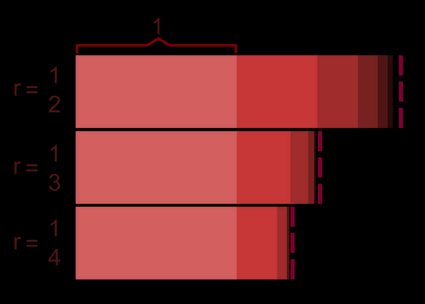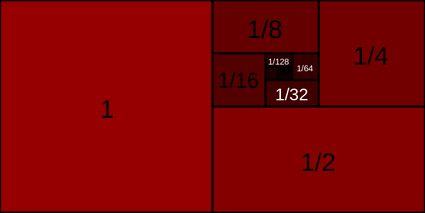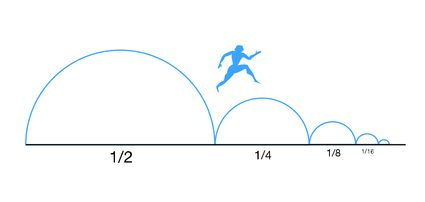Geometric Sequence Calculator
Calculate anything and everything about a geometric progression with our geometric sequence calculator. This geometric series calculator will help you understand the geometric sequence definition, so you could answer the question, what is a geometric sequence?
We explain the difference between both geometric sequence equations, the explicit and recursive formula for a geometric sequence, and how to use the geometric sequence formula with some interesting geometric sequence examples.
We also have built a "geometric series calculator" function that will evaluate the sum of a geometric sequence starting from the explicit formula for a geometric sequence and building, step by step, towards the geometric series formula.
Geometric sequence definition
The geometric sequence definition is that a collection of numbers, in which all but the first one, are obtained by multiplying the previous one by a fixed, non-zero number called the common ratio. If you are struggling to understand what a geometric sequences is, don't fret! We will explain what this means in more simple terms later on and take a look at the recursive and explicit formula for a geometric sequence. We also include a couple of geometric sequence examples.
Before we dissect the definition properly, it's important to clarify a few things to avoid confusion. First of all, we need to understand that even though the geometric progression is made up by constantly multiplying numbers by a factor, this is not related to the factorial (see factorial calculator). Indeed, what it is related to is the greatest common factor (GFC) and lowest common multiplier (LCM) since all the numbers share a GCF or an LCM if the first number is an integer.
This means that the GCF (see GCF calculator) is simply the smallest number in the sequence. Conversely, the LCM is just the biggest of the numbers in the sequence. For example, in the sequence 3, 6, 12, 24, 48, the GCF is 3, and the LCM would be 48. But if we consider only the numbers 6, 12, 24, the GCF would be 6 and the LCM would be 24.
Geometric progression: What is a geometric progression?
Now let's see what is a geometric sequence in layperson terms. A geometric sequence is a collection of specific numbers that are related by the common ratio we have mentioned before. This common ratio is one of the defining features of a given sequence, together with the initial term of a sequence. We will see later how these two numbers are at the basis of the geometric sequence definition, and depending on how they are used, one can obtain the explicit formula for a geometric sequence or the equivalent recursive formula for the geometric sequence.

Now, let's construct a simple geometric sequence using concrete values for these two defining parameters. To make things simple, we will take the initial term to be , and the ratio will be set to . In this case, the first term will be by definition, the second term would be , the third term would then be , etc. The n-th term of the progression would then be:
where is the position of the said term in the sequence.
As you can see, the ratio of any two consecutive terms of the sequence — defined just like in our ratio calculator — is constant and equal to the common ratio.
A common way to write a geometric progression is to explicitly write down the first terms. This allows you to calculate any other number in the sequence; for our example, we would write the series as:
However, there are more mathematical ways to provide the same information. These other ways are the so-called explicit and recursive formulas for geometric sequences. Now that we understand what is a geometric sequence, we can dive deeper into this formula and explore ways of conveying the same information in fewer words and with greater precision.
Recursive vs. explicit formula for geometric sequence
There exist two distinct ways in which you can mathematically represent a geometric sequence with just one formula: the explicit formula for a geometric sequence and the recursive formula for a geometric sequence. The first of these is the one we have already seen in our geometric series example. What we saw was the specific, explicit formula for that example, but you can write a formula that is valid for any geometric progression – you can substitute the values of for the corresponding initial term and for the ratio. The general formula for the n-th term is:
where means that . The explicit formula for geometric sequences conveys the most important information about a geometric progression: the initial term , how to obtain any term from the first one, and the fact that there is no term before the initial.
There is another way to show the same information using another type of formula: the recursive formula for a geometric sequence. It is made of two parts that convey different information from the geometric sequence definition. The first part explains how to get from any member of the sequence to any other member using the ratio. This meaning alone is not enough to construct a geometric sequence from scratch since we do not know the starting point. This is the second part of the formula, the initial term (or any other term for that matter). Let's see how this recursive formula looks:
where is used to express the fact that any number will be used in its place, but also that it must be an explicit number and not a formula. The subscript indicates any natural number (just like ), but it's used instead of to make it clear that doesn't need to be the same number as .
How to use the geometric sequence calculator?
Now that you know what a geometric sequence is and how to write one in both the recursive and explicit formula, it is time to apply your knowledge and calculate some stuff! With our tool, you can calculate all properties of geometric sequences, such as the common ratio, the initial term, the n-th last term, etc. Here's a brief description of how the calculator is structured:
- First, tell us what you know about your sequence by selecting one of the options:
- the common ratio and the first term of the sequence;
- the common ratio and some nth term; or
- some two terms;
- Input your data. Based on that, the calculator determines the whole of your geometric sequence.
- By default, the calculator displays the first five terms of your sequence. You can change the starting and final terms according to your needs.
Our tool can also compute the sum of your sequence: all of it or a final portion. In the latter case, it suffices to input the starting and final point of the sum, and you can enjoy the result. As you'll learn in the following sections, the infinite sum may not exist!
Geometric series formula: the sum of a geometric sequence
So far we have talked about geometric sequences or geometric progressions, which are collections of numbers. However, there are really interesting results to be obtained when you try to sum the terms of a geometric sequence. When we have a finite geometric progression, which has a limited number of terms, the process here is as simple as finding the sum of a linear number sequence. Calculating the sum of this geometric sequence can even be done by hand, theoretically.
But we can be more efficient than that by using the geometric series formula and playing around with it. To do this, we will use the mathematical sign of summation , which means summing up every term after it. For example, if we have a geometric progression named an and we name the sum of the geometric sequence S, the relationship between both would be:
if we want to sum the first m terms, or:
if we want to sum all terms.
Unfortunately, this still leaves you with the problem of actually calculating the value of the geometric series. You could always use this calculator as a geometric series calculator, but it would be much better if, before using any geometric sum calculator, you understood how to do it manually. There is a trick that can make our job much easier and involves tweaking and solving the geometric sequence equation like this:
Now multiply both sides by and solve:
This result is one you can easily compute on your own, and it represents the basic geometric series formula when the number of terms in the series is finite. However, this is math and not the Real Life™ so we can actually have an infinite number of terms in our geometric series and still be able to calculate the total sum of all the terms. How does this wizardry work? – I hear you ask. Well, fear not, we shall explain all the details to you, young apprentice.
Using the geometric sequence formula to calculate the infinite sum
After seeing how to obtain the geometric series formula for a finite number of terms, it is natural (at least for mathematicians) to ask how can I compute the infinite sum of a geometric sequence? It might seem impossible to do so, but certain tricks allow us to calculate this value in a few simple steps. For this, we need to introduce the concept of limit. This is a mathematical process by which we can understand what happens at infinity. It can also be used to try to define mathematically expressions that are usually undefined, such as zero divided by zero or zero to the power of zero.
Talking about limits is a very complex subject, and it goes beyond the scope of this calculator. Their complexity is the reason that we have decided to just mention them, and to not go into detail about how to calculate them. Do not worry though because you can find excellent information in the Wikipedia article about limits.
Even if you can't be bothered to check what the limits are, you can still calculate the infinite sum of a geometric series using our calculator. The only thing you need to know is that not every series has a defined sum. The conditions that a series has to fulfill for its sum to be a number (this is what mathematicians call convergence), are, in principle, simple. We explain them in the following section.
Remarks on using the calculator as a geometric series calculator
When it comes to mathematical series (both geometric and arithmetic sequences), they are often grouped in two different categories, depending on whether their infinite sum is finite (convergent series) or infinite / non-defined (divergent series). The best way to know if a series is convergent or not is to calculate their infinite sum using limits. Short of that, there are some tricks that can allow us to rapidly distinguish between convergent and divergent series without having to do all the calculations. These tricks include: looking at the initial and general term, looking at the ratio, or comparing with other series.

For a series to be convergent, the general term has to get smaller for each increase in the value of . If gets smaller, we cannot guarantee that the series will be convergent, but if is constant or gets bigger as we increase , we can definitely say that the series will be divergent. If we are unsure whether gets smaller, we can look at the initial term and the ratio, or even calculate some of the first terms. This will give us a sense of how evolves.
The second option we have is to compare the evolution of our geometric progression against one that we know for sure converges (or diverges), which can be done with a quick search online. Speaking broadly, if the series we are investigating is smaller (i.e., is smaller) than one that we know for sure that converges, we can be certain that our series will also converge. Conversely, if our series is bigger than one we know for sure is divergent, our series will always diverge. In the rest of the cases (bigger than a convergent or smaller than a divergent) we cannot say anything about our geometric series, and we are forced to find another series to compare to or to use another method.
These criteria apply for arithmetic and geometric progressions. In fact, these two are closely related with each other and both sequences can be linked by the operations of exponentiation and taking logarithms.
Zeno's paradox and other geometric sequence examples
We have already seen a geometric sequence example in the form of the so-called Sequence of powers of two. This is a very important sequence because of computers and their binary representation of data. In this progression, we can find values such as the maximum allowed number in a computer (varies depending on the type of variable we use), the numbers of bytes in a gigabyte, or the number of seconds till the end of UNIX time (both original and patched values).
On top of the power-of-two sequence, we can have any other power sequence if we simply replace with the value of the base we are interested in. Power series are commonly used and widely known and can be expressed using the convenient geometric sequence formula. But this power sequences of any kind are not the only sequences we can have, and we will show you even more important or interesting geometric progressions like the alternating series or the mind-blowing Zeno's paradox.
Let's start with Zeno's paradoxes, in particular, the so-called Dichotomy paradox. This paradox is at its core just a mathematical puzzle in the form of an infinite geometric series. Zeno was a Greek philosopher that pre-dated Socrates. He devised a mechanism by which he could prove that movement was impossible and should never happen in real life. The idea is to divide the distance between the starting point (A) and the finishing point (B) in half. Once you have covered the first half, you divide the remaining distance half again… You can repeat this process as many times as you want, which means that you will always have some distance left to get to point B.

Zeno's paradox seems to predict that, since we have an infinite number of halves to walk, we would need an infinite amount of time to travel from A to B. However, as we know from our everyday experience, this is not true, and we can always get to point A to point B in a finite amount of time (except for Spanish people that always seem to arrive infinitely late everywhere). The solution to this apparent paradox can be found using math.
If we express the time it takes to get from A to B (let's call it for now) in the form of a geometric series, we would have a series defined by: with the common ratio being . So the first half would take to be walked, then we would cover half of the remaining distance in , then , etc… If we now perform the infinite sum of the geometric series, we would find that:
This is the mathematical proof that we can get from A to B in a finite amount of time ( in this case).
To finish it off, and in case Zeno's paradox was not enough of a mind-blowing experience, let's mention the alternating unit series.
This series starts at and has a ratio which yields a series of the form:
This does not converge according to the standard criteria because the result depends on whether we take an even () or odd () number of terms. There is a trick by which, however, we can "make" this series converges to one finite number. The trick itself is very simple, but it is cemented on very complex mathematical (and even meta-mathematical) arguments, so if you ever show this to a mathematician you risk getting into big trouble (you would get a similar reaction by talking of the infamous Collatz conjecture). You've been warned. Let's see the "solution":
We multiply both sides by :
If we solve for now:
Now you can go and show-off to your friends, as long as they are not mathematicians.
FAQs
What is the geometric sequence?
A geometric sequence is a series of numbers such that the next term is obtained by multiplying the previous term by a common number.
How to find the sum of a geometric sequence?
To find the sum of a geometric sequence:
- Calculate the common ratio,
rraised to the powern. - Subtract the resultant rⁿ from
1. - Divide the resultant by
(1 - r). - Multiply the resultant by the first term, a₁.
How to find the nth term of a geometric sequence?
To find the nth term of a geometric sequence:
- Calculate the common ratio raised to the power
(n-1). - Multiply the resultant by the first term,
a.
How to calculate the common ratio of a geometric sequence?
To calculate the common ratio of a geometric sequence, divide any two consecutive terms of the sequence.